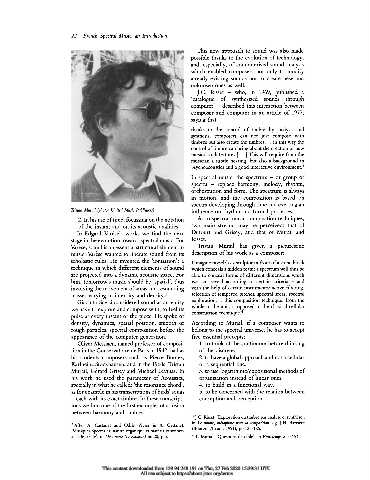Page 251 - HandbookMarch1
P. 251
22 French Spectral Music: an Introduction
This new approach to sound was also made
possible thanks to the evolution of technology,
and, especially, of computerized sound analysis
which enabled composers not only to modify
already existing sounds but to create new and
unknown ones as well.
J.C. Risset - who, in 1969, published a
'catalogue of synthesized sounds through
computer' - described this interaction between
composer and computer in an article of 1977,
saying that
thanks to the control of timbre by analysis and
synthesis, composers can not just compose with
timbres but also create the timbres... in this way the
control of timbre can bring about the creation of new
musical architectures [.. .] This will require from the
musician a subtle hearing, but also a background in
psychoacoustics and a good interactive environment.3
In spectral music, the spectrum - or group of
spectra - replace harmony, melody, rhythm,
orchestration and form. The spectrum is always
in motion, and the composition is based on
spectra developing through time and exerting an
Tristan Murail (photo: United Music Publishers) influence on rhythm and formal processes.
2. In his use of time, focussing on the notation As to spectral music composition techniques,
of the instant and on its acoustic qualities. two main streams may be perceived: that of
In Edgard Varese's works we find the next Dufourt and Grisey, and that of Murail and
stage in the evolution towards spectral music. For Risset.
Varese, sound is an essential structural element in Tristan Murail has given a picturesque
music. Varese wanted to liberate sound from its description of his work as a composer:
scholastic rules. He invented the 'ionisation': a I imagine myself as a sculptor in front of a stone block
technique in which different elements of sound which conceals a hidden form; a spectrum will thus be
are projected into a dynamic acoustic space. For able to conceal forms of different dimensions which
him, tomorrow's music should be 'spatial', thus we can reveal according to certain criteria - and
involving the movement of areas and resounding with the help of certain instruments: active filtering,
masses varying in intensity and density.2 selection of tempered pitches, spectral areas, spectral
Giacinto Scelsi considered sound as an entity exploration. . . this composition technique, from the
whole to the unit, is opposed to the classical cellular
we have to explore and compose with, to feel its
construction technique.4
pulse at every instant of the piece. He spoke of
density, dynamics, spatial position, smooth or According to Murail, if a composer wants to
rough particles, spectral composition before the belong to the spectral universe, he has to accept
appearance of the computer generation. five essential precepts:
Oliver Messiaen, named professor of composi- 1. to think of the continuum before thinking
tion in the Conservatoire de Paris in 1942, had as of the discrete.
his students composers such as Pierre Boulez, 2. to have a global approach and not a cellular
Karlheinz Stockhausen, and in the 1960s: Tristan or a sequential one.
Murail, Gerard Grisey and Michael Levinas. In 3. to use logarithmic/expositional methods of
his work he used the parameter of Acoustics, organization instead of linear ones.
specially in what he called: 'the resonance chord', 4. to build in a functional way.
as for example in his transcriptions of birds' songs 5. to be concerned with the relation between
- each with its exact timbre. In these transcript- conception and perception.
ions we find one of the first examples of a fusion
between harmony and timbre.
3 J.C. Risset, 'Exploration du timbre par analyse et synthese',
2 After A. Castanet and Odile Vivier in A. Castanet, in Le timbre, mdtaphore pour la composition, eg. J.H. Barriere
'Musiques Spectrales: nature organique et materiaux sonores (Bourgois/Ircam, 1991), pp.125-126.
au 20e siecle', in Dissonanz (Dissonance) no.20, p.5. 4 T. Murail, 'Questions de cible', in Entretemps 8, p.154.
This content downloaded from 139.94.248.191 on Thu, 27 Feb 2020 15:39:31 UTC
All use subject to https://about.jstor.org/terms

